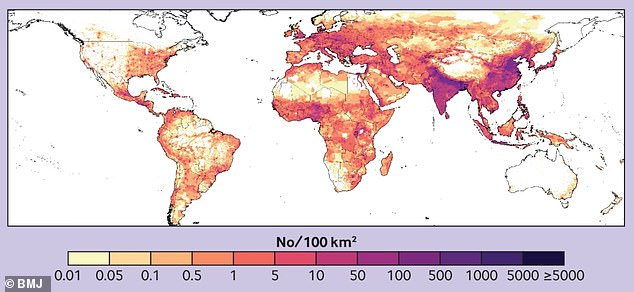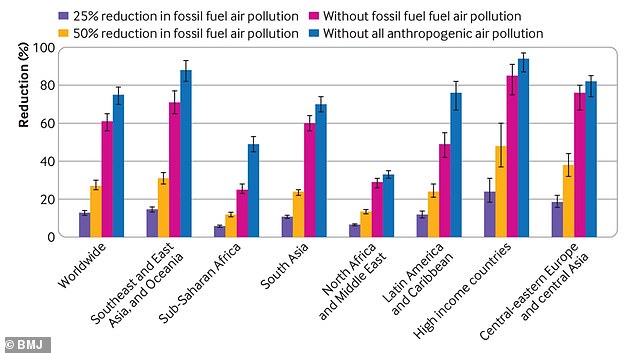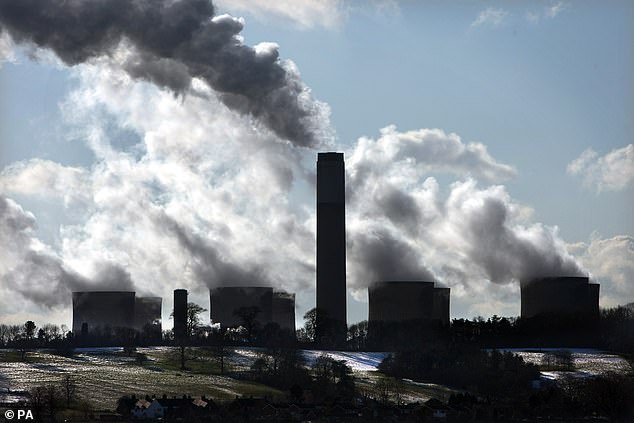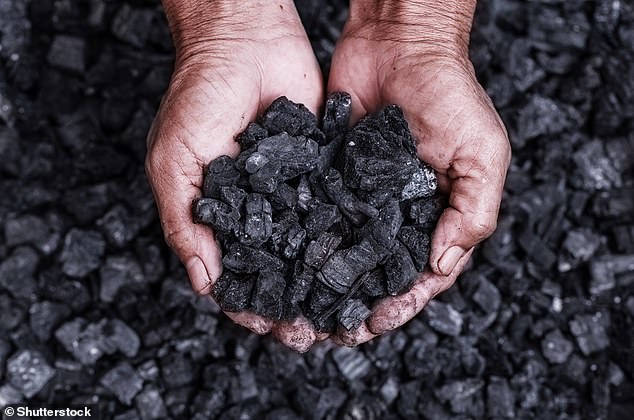The fatal effect of fossil fuels: Air pollution accounts for 5.1 MILLION extra deaths a year worldwide, shocking study reveals
>
A shocking new study has revealed the deadly impact of inhaling emissions from the use of carbon-belching fossil fuels such as gas and coal.
Scientists say the use of fossil fuels for power generation, transportation and industrial processes such as steelmaking causes an additional 5.13 million deaths annually worldwide.
It turns out that death rates are highest in countries that have lagged behind in ending the burning of coal for energy production – namely China and India.
These findings add a sense of scale to what we already know about the deadly effects of polluted air, including cardiovascular disease, asthma and lung cancer.
Phasing out fossil fuels to power human activities in favor of renewable energy sources such as solar and wind could reduce millions of avoidable deaths.
The phase-out of fossil fuels may have a greater impact on global deaths than previously thought, according to an international team of experts. Deaths caused by emissions from fossil fuels usually result from industry, transportation, and power generation. Coal burning contributes more than half of these emissions. Pictured are emissions from a coal-fired power plant

Deaths attributable to all sources of ambient air pollution were highest across South and East Asia, particularly in China with 2.44 million per year, followed by India with 2.18 million per year.
The new study was conducted by an international team of experts, including British epidemiologist Andy Haines at the London School of Hygiene and Tropical Medicine.
“The results show that the burden of deaths attributable to air pollution caused by fossil fuel use is higher than most previous estimates,” they say.
“Phasing out fossil fuels is an effective intervention to improve health and save lives.
“Deaths (due to air pollution) are particularly high in South and East Asia, due to high levels of pollution and population density.”
Researchers say deadly pollutants in outdoor air include ozone (O3), which is created by reactions between nitrogen oxides and volatile organic compounds, both of which are emitted by vehicles, industrial and other processes.
At ground level, ozone causes the smog commonly seen in cities and can cause breathing problems, especially for frail people with lung diseases such as asthma.
Another nasty pollutant known as PM2.5, are tiny particles or droplets with a diameter of less than 2.5 micrometers, which are invisible to the naked eye and can be inhaled even with our awareness.
Inhaling PM2.5 is already thought to cause asthma, lung and heart disease, and even symptoms of depression, but many of its health effects remain to be discovered.
In the new study, researchers used computer modeling to evaluate the relationship between air pollution exposure and health outcomes around the world.
Data sources for the model included population figures, NASA satellite images, and insights from the 2019 Global Burden of Disease Study, which determines national and regional death rates.

Particulate matter, or PM, comes from a variety of sources, including vehicle exhaust, construction sites, industrial activity, or even home stoves and ovens. PM2.5 are pollutant particles that are 2.5 micrometers or smaller in size
The results showed that in 2019, 8.34 million deaths worldwide were attributable to fine particulate matter (PM2.5) and ozone (O3) in ambient air, of which 61 percent (5.13 million) were linked to fossil fuels.
The remaining 39% of non-fossil fuel air pollution comes from unavoidable natural sources, such as desert dust and forest fires, as well as residential energy use, such as burning solid biofuels for cooking and heating.
The researchers found that deaths caused by fossil fuel air pollution were highest in South and East Asia, especially in China, where they reached 2.44 million annually, followed by India with 2.18 million annually.
Just over half of all deaths (52 percent) were related to cardiovascular diseases, especially coronary heart disease (30 percent).
Meanwhile, stroke and chronic obstructive pulmonary disease — a group of lung conditions that cause breathing problems — account for 16%.
About 20% of them were “unspecified” but were likely related in part to high blood pressure and neurological disorders such as Alzheimer’s and Parkinson’s disease.
As part of the study, the researchers also looked at four different scenarios to evaluate potential health benefits from policies that replace fossil fuels with clean, renewable energy sources.
The team found that phasing out fossil fuels would lead to the largest reductions in deaths in South, Southeast and East Asia, amounting to about 3.85 million per year.
This equates to between 80 percent and 85 percent of preventable deaths caused by all anthropogenic sources of ambient air pollution in these areas.

The greatest reductions in mortality from phasing out fossil fuels can be achieved in high-income countries (85 percent) that rely largely on fossil energy, specifically those in Asia.

Fine particulate matter (PM) is emitted during the combustion of solid and liquid fuels, such as for power generation, home heating, and in vehicle engines. In the photo, London is obscured by pollution
A big part of the problem is that although fossil fuels have been replaced by renewable sources of power generation in countries like the UK, other activities such as the cement and steel industry are still heavily dependent on fossil fuels.
In the UK, there is only one remaining coal-fired power station – at Ratcliffe-on-Soar, Nottingham – but it will close in September 2024.
Two other companies – West Burton A in Lincolnshire and Kellot in Northern Ireland – stopped generating electricity using coal earlier this year.
Despite the phase-out of coal, the government last year approved the construction of a new British coal mine in Whitehaven, Cumbria.
The coal mine will extract coke, which is used to make steel rather than generate electricity, but is still responsible for carbon emissions.
As the COP28 climate summit begins on Thursday, researchers are urging leaders to commit to an accelerated phase-out of fossil fuels across all activities – and say high-income countries must lead the way.

Ratcliffe-on-Soar Power Station, one of three active coal-fired power stations in the UK. It is scheduled to close in September 2024

Fossil fuels such as coal (pictured) and gas release huge amounts of greenhouse gases into the air
“The benefits of phasing out fossil fuels on global health, as well as climate, should be recognized and play a key role in shaping discussions at COP28,” the researchers concluded in their paper.
Phasing out fossil fuels would save millions of lives, researchers from Finland and Norway agree Accompanying editorialBut they add that deaths are only “part of the problem.”
“Improving air quality would reduce the burden of many major diseases leading to healthier and longer lives, fewer patients requiring hospitalization and other treatments, and reducing the burden on health systems around the world,” they say.
“Clean renewable energy sources are needed to replace fossil fuels.”
The study was published today in British Medical Journal.
(Tags for translation)dailymail
